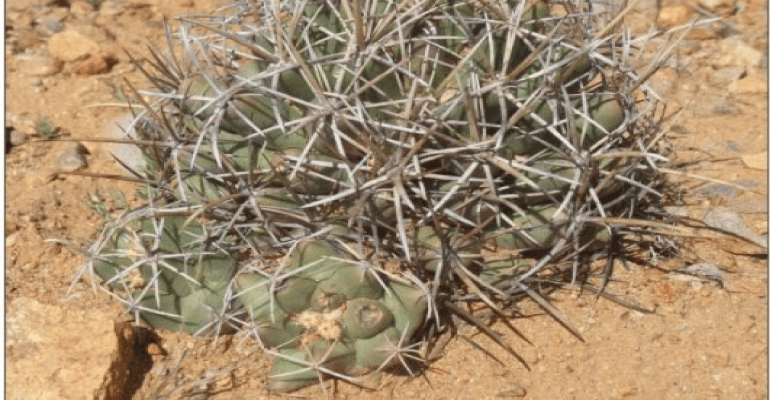
The Pima Pineapple cactus (Coryphantha scheeri var. robustispina) is a small (pineapple-sized) cactus that inhabits grasslands and desert scrub in Pima County and parts of Santa Cruz County, Arizona, and parts of northern Sonora, Mexico, at elevations below 4,000 feet. About 90 percent of its historic range is in Pima County.
The cactus is sparsely distributed within its range, but does have some high-density clusters. According to the U.S. Fish & Wildlife Service (FWS) this species is incapable of self-fertilization, which means pollen from another individual cactus is required.
The Pima Pineapple cactus is a low-growing hemispherical cactus that may be found as single or multi-stemmed plants. Mature plants measure 4-18 inches tall and 3-7 inches in diameter. The spines are stout and arranged in clusters with one central hooked spine and 6-15 radial straight spines. Spines are originally straw colored, but become black with age. Flowers are yellow and the fruit is a green ellipsoid. See photos here. The flowers are pollinated mainly by bees. Seeds are dispersed by rodents, rabbits, and ants.
Because the cactus is small and inconspicuous, it is subject to danger from grassland fires, livestock grazing, off-road vehicles, and housing development.
The Pima Pineapple cactus was listed as endangered by FWS on September 23, 1993. FWS never got around to establishing “critical habitat” but now is proposing a recovery plan which you can read here (76 pages). If we follow the plan, which will cost $62,910,560, FWS says they can delist the cactus by the year 2046. There have been many studies of the cactus, but FWS still doesn’t know how many there are scattered around its habitat.
The main recommendations of the recovery plan boil down to protecting existing habitat from human intervention, invasive species, and wildfires. In other words, restrict land usage. FWS also recommends acquisition of private lands to increase habitat and limit development.
The plan recommends monitoring the cactus for at least 15 years. It so happens that Buenos Aires National Wildlife Refuge established in 1985, comprising 117,464-acres, lies in southern Pima County within the range of the cactus. Has not the FWS been paying attention to the cactus on the Refuge during the past 25 years?
I have an alternative suggestion. In order to preserve the cactus, delist it and farm it. Buenos Aires National Wildlife Refuge could be used as an initial farm stock source with many plots dedicated to the cactus. FWS could, if the cactus were delisted, allow commercial nurseries to grow and sell the plants to people who would like them for their yards or gardens, something that is problematical as long as the cactus is listed as “endangered.” This small cactus would make a good potted plant for porches and patios.
See also:
Note to readers:
- Index with links to all my ADI articles: http://wp.me/P3SUNp-1pi
- My comprehensive 28-page essay on climate change: http://wp.me/P3SUNp-1bq
- A shorter ADI version is at https://arizonadailyindependent.com/2013/08/01/climate-change-in-perspective/
If you like murder mysteries, type the name Lonni Lees (my wife) into Amazon or Barnes & Noble sites to see her novels, a book of short stories, and reviews. For synopses and more reviews of her books see: https://wryheat.wordpress.com/lonnis-murder-mysteries/
